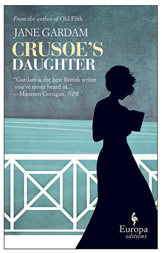Crusoe’s Daughter by Jane Gardam
This is my third Gardam book in as many months. Having enjoyed Old Filth and The Man in the Wooden Hat, I turned to Crusoe’s Daughter which I picked up last Fall at Crawford Doyle.
Stylistically this novel published in 1985 is not dissimilar to the others, but Crusoe’s Daughter is an entirely original work and a personal favorite of Gardam’s.
Gardam was inspired by her mother’s childhood in north-east England in the early 20th C. In the small fishing village located next to a massive marsh, girls were expected to marry soon and appropriately (no farmers, dear!), have children, stay home and never express a desire for any intellectual stimulation beyond the Bible. Considering the shortage of men after WWI, the first two expectations were particularly harsh. The obligation never to work outside the home all but guaranteed a life of genteel poverty, and the lack of intellectual stimulation well, enough said– altogether a stifling life.
Presumably Gardam’s mom fared a bit better than the protagonist of Crusoe’s Daughter, Polly Flint.
In 1904 a motherless Polly is dropped off by her father at her aunts’ yellow house on the marsh. Father dies shortly thereafter, and Polly lives the rest of her long life in the yellow house.
Despite the ban on education, the yellow house contains a wonderful library, which Polly eagerly avails herself. Polly grows up intellectually precocious, but woefully short of real-life experience.
In her isolated life, her dearest friend is a fictional character, Robinson Crusoe, Defoe’s self-sufficient hero. Crusoe is not just her friend but her religion; her devotion is obsessive and unwavering.
Over time the marsh shrinks, and Polly’s sheltered life expands in unexpected ways. Polly not only occupies the little yellow house but fulfils its promise. And she never gives up Crusoe.
A novel read.
